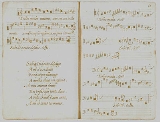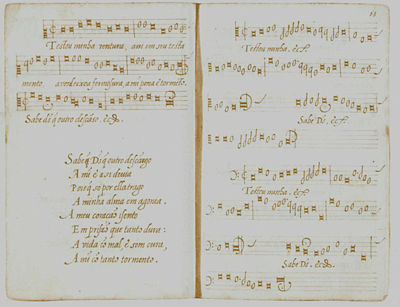
Cancioneiro de Elvas
Encyclopedia
The Cancioneiro de Elvas (in English: Elvas Songbook) is one of the four Renaissance
songbooks of Portuguese music
from the 16th century - along with the Lisbon Songbook, the Belém Songbook
, and the Paris songbook
. It is one important source of secular music
from the Iberian Renaissance.

The musical part of the songbook has been studied and transcribed by three musicologists - Manuel Joaquim, Manuel Morais and Gil Miranda.
Thus, we can conclude that the Elvas Songbook was copied between the decades of 1560 and 1570, approximately.
Renaissance music
Renaissance music is European music written during the Renaissance. Defining the beginning of the musical era is difficult, given that its defining characteristics were adopted only gradually; musicologists have placed its beginnings from as early as 1300 to as late as the 1470s.Literally meaning...
songbooks of Portuguese music
Music history of Portugal
-Liturgical repertoire:In the early days of the Catholic Church, several local liturgies developed, such as the Gallican in France, the Sarum in England, the antique Roman in Rome, the Ambrosian rite in Milan...
from the 16th century - along with the Lisbon Songbook, the Belém Songbook
Cancioneiro de Belém
The Cancioneiro Musical de Belém or simply Cancioneiro de Belém is a Renaissance Portuguese manuscript from the beginning of the 17th century....
, and the Paris songbook
Cancioneiro de Paris
The Cancioneiro de Paris is one of the four Renaissance songbooks of Portuguese music from the 16th century. It is one important source of secular music of the Iberian Renaissance and the largest one of Portuguese secular Renaissance music.It contains 130 profane villancicos and cantigas...
. It is one important source of secular music
Secular music
Secular music is non-religious music. "Secular" means being separate from religion.In the West, secular music developed in the Medieval period and was used in the Renaissance. Swaying authority from the Church that focused more on Common Law influenced all aspects of Medieval life, including music...
from the Iberian Renaissance.

General description
The Elvas Songbook was found in 1928 in the library of Elvas, by the musicologist Manuel Joaquim. It was copied in the 16th century and is divided in two parts:- The first part is musical: contains 65 works of polyphonic (3 voices) secular music from PortugalPortugalPortugal , officially the Portuguese Republic is a country situated in southwestern Europe on the Iberian Peninsula. Portugal is the westernmost country of Europe, and is bordered by the Atlantic Ocean to the West and South and by Spain to the North and East. The Atlantic archipelagos of the...
and SpainSpainSpain , officially the Kingdom of Spain languages]] under the European Charter for Regional or Minority Languages. In each of these, Spain's official name is as follows:;;;;;;), is a country and member state of the European Union located in southwestern Europe on the Iberian Peninsula...
. The poems used are villancicoVillancicoThe villancico was a common poetic and musical form of the Iberian Peninsula and Latin America popular from the late 15th to 18th centuries. With the decline in popularity of the villancicos in the 20th century, the term became reduced to mean merely "Christmas carol"...
s and cantigaCantigaA cantiga is a medieval monophonic song, characteristic of the Galician-Portuguese lyric. Over 400 extant cantigas come from the Cantigas de Santa Maria, narrative songs about miracles or hymns in praise of the Holy Virgin...
s.
- The second part is literary: contains 36 poems without music.
The musical part of the songbook has been studied and transcribed by three musicologists - Manuel Joaquim, Manuel Morais and Gil Miranda.
Dating of the Songbook
There are no dates in the manuscript, therefore it is impossible to know the precise date of compilation. However, some factors can help us to narrow the time frame:- There is a song in the songbook which uses a poem written by the poet Dom Manuel de Portugal, dedicated to his beloved Dona Francisca de Aragão. This poem is known to have been written in c. 1555;
- The watermark in the pages of the manuscript is similar to one used in Italy until the decade of 1570.
Thus, we can conclude that the Elvas Songbook was copied between the decades of 1560 and 1570, approximately.
Composers
There is not a single reference on composers in the songbook: all works are anonymous. However, if we compare this songbook with other Iberian songbooks, it is possible to establish concordances and thus know which are the composers of 7 (maybe 8) works from the 65 compiled. They are:- Juan del EncinaJuan del EncinaJuan del Enzina – the spelling he used – or Juan del Encina – modern Spanish spelling – was a composer, poet and playwright, often called the founder of Spanish drama...
(4 works)
- Pedro de EscobarPedro de EscobarPedro de Escobar , a.k.a. Pedro do Porto, was a Portuguese composer of the Renaissance, mostly active in Spain. He was one of the earliest and most skilled composers of polyphony in the Iberian Peninsula, whose music has survived.-Life:He was born at Oporto, Portugal, but nothing is known of his...
(2 or 3 works)
- Pedro de Pastrana (1 work)

